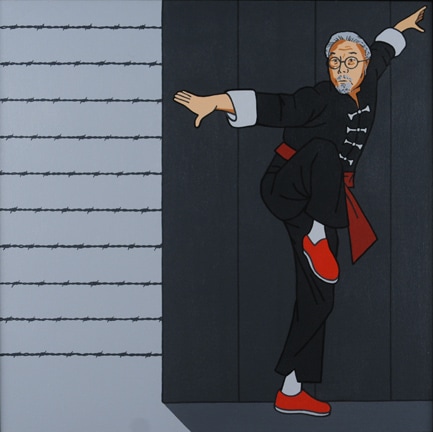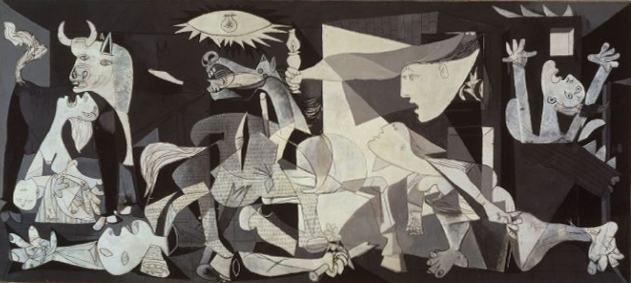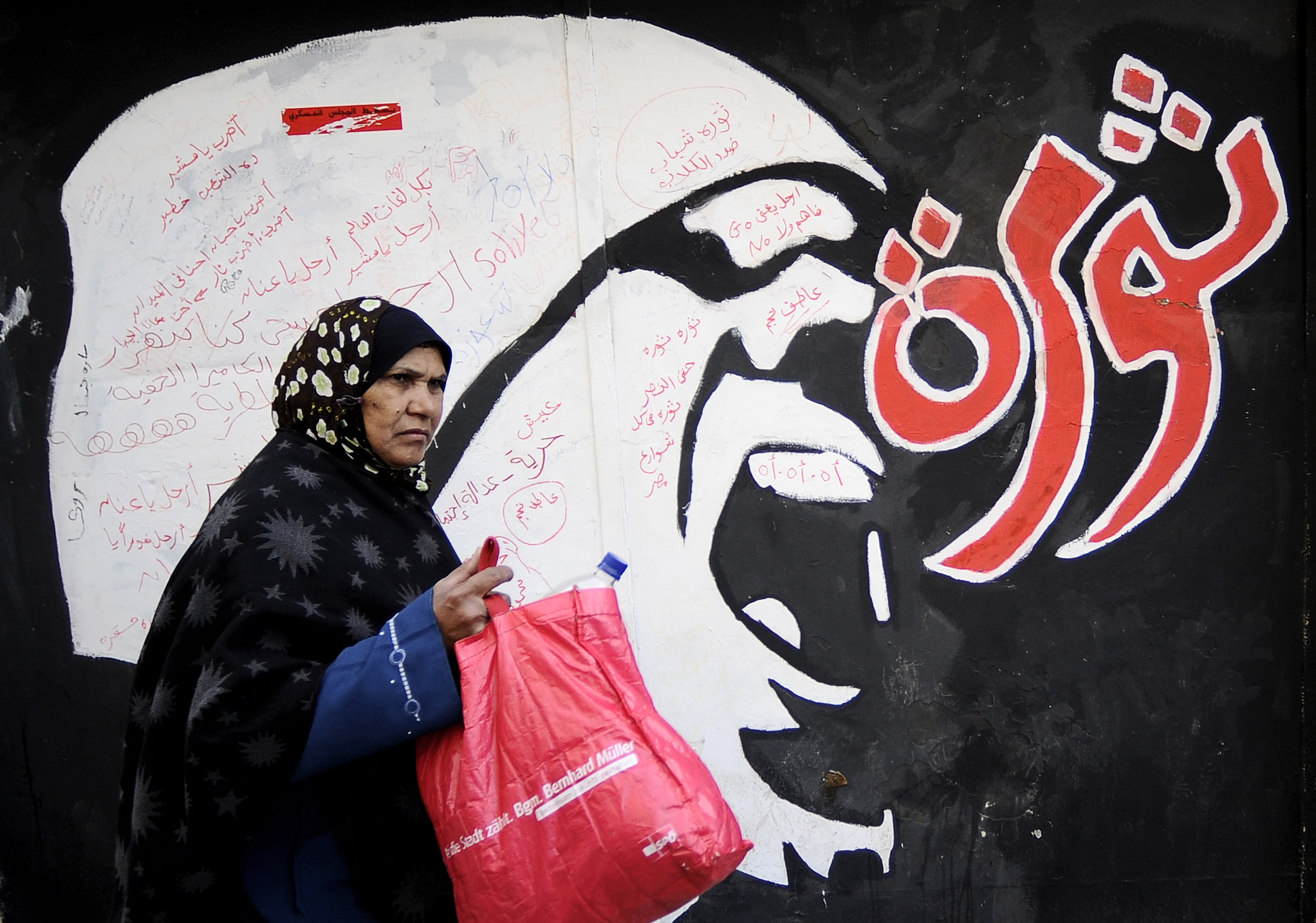On December 11th, 2011, helmeted soldiers dragged a woman’s limp, badly beaten body through Tahrir Square in Cairo, Egypt.
In the iconic photograph capturing the moment, the woman’s raised abaya covered her face, exposing her blue bra, an almost incandescent article of clothing against the gray pavement and camouflage uniforms. One soldier’s foot, suspended in the air, targeted her torso. The woman’s identity was never discovered, but the image of her, coupled with the video of her brutal assault, inspired a massive women’s march through the streets of Cairo. Three months after the photo was taken, after continued unrest, Egyptian President Hosni Mubarak, who had ruled for nearly three decades, resigned.
The blue bra—which occurred one year into the Arab Uprising, the revolution sparked by the self-immolation of Mohamed Bouazizi in Sidi Bouzid, Tunisia—soon became a symbol of the Egyptian Revolution. On Mohammed Mahmoud Street, one unknown artist reproduced the assault as a wall mural. Over time, residents in the community revised the mural by covering the woman’s body and adding devil horns and tails on the baton-wielding soldiers. Another artist, Bahia Shehab, created a mural series featuring stencils of the blue bra entitled, “No, and a Thousand Times No.”
Photos of the murals are featured in an online exhibit, Creative Dissent: Arts of the Arab World Uprising, co-curated by Nama Khalil. Khalil traveled to Egypt in 2013 and 2014, at the tail end of the Uprising, and witnessed much of the street art firsthand.
“For the people of Egypt, the murals were therapeutic,” she says. “They were specific, deliberate, and captured the moment. They documented what people were thinking, what people were referencing,” and conveyed outrage over an authoritarian regime. But what struck her most about the mural art was how effective it was in uniting dissenters into viable protest networks. “People who met one another by running away from bullets would call each other up to work on a mural,” she says.
The collaboration on the art nurtured the collaborative political action that followed. It’s a specific sort of group participation, one that could soon prove helpful in the United States.
Since assuming office, President Donald Trump has come under fire for endorsing policies that would effectively curb expressions of dissent. Trump supports jailing and revoking citizenship for people who burn the American flag. His administration has shut down or threatened federal agencies’ social media accounts. He’s banned major media outlets from press briefings.
In March, Trump unveiled his new budget, which would excise the $148 million budget for the National Endowment for the Arts, the $148 million budget for the National Endowment for the Humanities, the $445 million budget from the Corporation of Public Broadcasting, and the $230 budget million for the Institute of Museum and Library Services.
It was a chilling proclamation that would have had devastating, long-term effects not just on individual artists, but on schools, libraries, museums, and community centers. It also didn’t last long: Congress intervened earlier this month, saving funding for the Public Broadcasting Service and National Public Radio. The NEA also surprisingly received its requested funds of $150 million, and CPB and NEH remain safe, at least until September of this year.
But these victories may be short-lived. The threat of cuts to the arts continues to loom large.
“Crisis oftentimes provides a productive and generative moment for artists.”
Jacqueline Francis, an art historian specializing in American art of the contemporary African Diaspora, has been watching the Trump administration’s actions with respect to the arts closely. And even though the president’s intentions concern her, she believes that protest or resistance art, which challenges oppressive governments or social norms, will remain viable and intact under Trump.
“Protest art is not going to stop a bullet, but it does stir the mind and the heart. Artists want to create something pleasing but that also gets a rise out of people,” Francis says. “A still life is not going to make you change your voting pattern.” She points to Pablo Picasso’s 1937 painting “Guernica,” which cast a spotlight on war and the bombing of the Basque town. “The message of this kind of art is: ‘I see this. I know what’s going on.'”
And the artists who create this kind of art often find the ways and the means to keep working, despite the dire circumstances they may find themselves in. Jews imprisoned in death camps created protest art during the Holocaust. South Africans produced art during Apartheid, as did Chilean artists under Pinochet, and black artists during Jim Crow. “Art has existed under every kind of political regime,” she says. “Artists know they have to be resourceful, and canny, and opportunistic. Crisis oftentimes provides a productive and generative moment for artists.”
But the art doesn’t always survive, says Francis, and protest artists who challenge oppressive and powerful systems may face serious risks. “The state threatens, harasses, censors, and silences artists, who make political work that threatens authority,” she says, citing Tania Brugera, a Cuban installation and performance artist whose pieces have advocated for freedom of expression, and Chinese artist Ai Weiwei, whose work has criticized corruption, human rights violations, and xenophobia. Both Brugera and Weiwei have been arrested, interrogated, and detained by their countries’ governments because of the art they created.
With the U.S.’s current political landscape, defined by xenophobia and bigotry, the soil is fertile for protest art. But there may be consequences to those who create it.

One of Roger Shimomura‘s earliest memories is of the celebration of his third birthday in 1942 at Camp Harmony in Tuyallup, Washington, a temporary U.S. government prison for Japanese-Americans awaiting assignment to more long-term concentration camps. Two and a half months later, along with his parents and both sets of grandparents, Shimomura was sent to Minidoka Camp in southern Idaho. His younger sister, Carolyn was born there.
When anti-Muslim sentiment increased sharply during Trump’s campaign, the Japanese-American community, including Shimomura, feared Muslim-Americans would face the same kind of discrimination and detention that Japanese-Americans endured during World War II. “The similarities between what I experienced as an incarcerated child during World War II and President Trump’s statements that he might consider the same consequences for Muslim-Americans is frightening,” he says.

(Photo: Courtesy of the Flomenhaft Gallery)
This fear has inspired some of Shimomura’s most recent art work. About one-third of the 29 paintings currently being exhibited at New York City’s Flomenhaft Gallery, draw parallels between the incarceration of Japanese-Americans during World War II and anti-Muslim bigotry. “Two Prisoners,” for example, portrays a Japanese woman and a Muslim woman behind barbed wire. The two communities, Shimomura says, “may share the same fate” because our government possesses “a very short memory for wrong doings.”
It’s a distressing kind of déjà vu, especially for Japanese-American survivors, and one that illuminates a harrowing, contemporary truth. “For most ‘minorities’ in this country,” Shimomura says, “it seems that xenophobia rests just below the surface of everyday civil life.”

“Art is inherently intertwined with resistance. It always has been,” says Indigenous artist Canuppa Hanska, who was born in Fort Yates on the Standing Rock Reservation in North Dakota, just 30 miles south of Sacred Stone Camp.
For Hanska, art can also be a reflector—a literal one. Inspired by demonstrations in Kiev, Ukraine, in 2014 known as “Euro Maiden,” where women held up mirrors to armed forces, Hanska made mirrored shields for the water protectors at Standing Rock. “I wanted to help create a more solid line to hold space, to protect them from pepper spray and rubber bullets,” and to reflect the image of armed law enforcement’s violent response to unarmed peaceful prayer back to them.
Ultimately, Hanska hopes his resistance art will help protect and preserve his people’s cultural practices, rather than serve as struggle porn or as a commodity. “If I’m just making aesthetic work for purchase,” he says, “then I have failed the long and rich history of artists who produce art as a source for community engagement.”

(Photo: Wikimedia Commons)
Protest art disrupts the dominant media narrative, which, post-election has centered the needs of white privilege and white fragility, and continues to offer platforms for bigots without questioning or challenging their bias.
Antonio Serna, a painter and media critic, was disturbed by how the media portrayed the Iraq War that began in 2003. He created a two-page newspaper “wrapper” (meant to wrap around the front and back pages of a newspaper) called “Good Morning Baghdad.” The piece incorporated real photos of American bombings in Iraq he found online, and listed the statistics of civilian fatalities he felt were missing from mainstream media coverage of the war.
“Everyone likes to think that the media is neutral,” he says, “but it isn’t. How the news is framed and presented affects policies and people.” And protest art, he says, tends to focus on the most marginalized communities. It elucidates their truth.

Two-and-a-half million undocumented people were deported during Barack Obama’s eight years in office, the most of any U.S. president. Trump intends to outdo the Obama administration on this front. On January 25th, 2017, he signed an executive order expanding mass deportation to include undocumented people who had not committed serious crimes. He reinstated 287(g), a federal program that allows Immigration and Customs Enforcement to utilize state and local law enforcement to identify undocumented people.
Alberto Ledesma understands the fear right now in the undocumented community. At age eight, he emigrated from a small town in northern Jalisco, Mexico, with his mother and two sisters to spend the summer with his father in Oakland, California. The family never returned to their homeland. Ledesma became a citizen at age 25, when President Ronald Reagan signed a 1986 law granting three million undocumented immigrants citizenship.
Ledesma says one of the hardest things about being undocumented, particularly a poor undocumented youth, is the lack of agency, and the inability to adopt an autonomous identity and “forge a narrative” that counters the blame and erasure foisted upon undocumented people.
One of his pieces drawn with copic markers, “There Is No Back of the Line,” (inspired by Diego Rivera’s 1931 “The Uprising“), illuminates the near insurmountable burdens placed upon poor immigrants who are simply seeking a safe home. “If you’re illegal, you’re expected to get in the back of the line, to wait your turn for citizenship.” It’s a Catch-22, he says, because people who are poor will never have enough money to navigate the bureaucracy and racism ingrained in U.S. immigration policies.

(Photo: Filippo Monteforte/AFP/GettyImages)
The walls in Egypt have been whitewashed since the revolution. The creative protest movement has gone digital in the form of short films and documentaries on alternative independent media. Political upheaval has continued to plague the country, and after a massacre of nearly 1,000 people in August of 2013, then President Adly Mansour, before he was ousted in a military coup, enacted a 2013 law that severely restricted protests. “The creation of that kind of dissent in public art,” says Khalil, despite the presence of a democratically elected leader, President Abdel Fattah el-Sisi, “is too dangerous now.”
What’s the point of protest art if it’s painted over, torched, or trampled upon? If its creators go to jail?
“It will continue to resist tyrannies, dictatorships, and xenophobia in the empathy it leaves behind,” Ledesma says.
It will embolden disenfranchised people to imagine and define freedom. It will speak their truths.
Lead Photo: Protest art in Oakland. (Photo: Thomas Hawk/Flickr)





